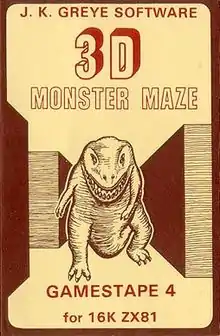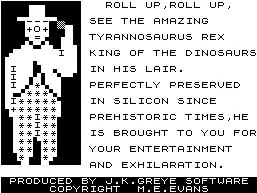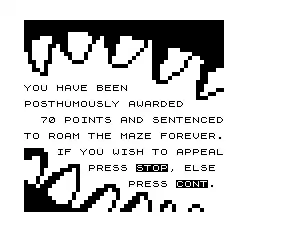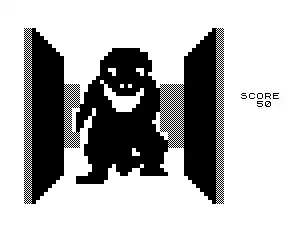3D Monster Maze
3D Monster Maze is a computer game developed from an idea by J.K. Greye and programmed by Malcolm Evans in 1981 for the Sinclair ZX81 platform with the 16 KB memory expansion. The game was initially released by J. K. Greye Software in early 1982 and re-released later the same year by Evans' own startup, New Generation Software. Rendered using low-resolution character block "graphics", it was one of the first 3D games for a home computer,[1] and one of the first games incorporating typical elements of the genre that would later be termed survival horror.
| 3D Monster Maze | |
|---|---|
 The tape cover | |
| Developer(s) | Malcolm Evans |
| Publisher(s) | J. K. Greye Software |
| Platform(s) | Sinclair ZX81 |
| Release | 1981 |
| Genre(s) | First-person adventure |
| Mode(s) | Single-player |
3D Monster Maze puts the player in a maze with one exit and a hostile monster, the Tyrannosaurus rex. There, the player must traverse the maze, from the first-person perspective, and escape through the exit without being eaten.
J.K.Greye Software went on to become a very successful games company publishing 6 Game Tapes for the Sinclair ZX81 - 2 in 3D - 3D Monster Maze & 3D Defender, both designed by J.K.Greye and programmed by Malcolm Evans.
New Generation Software went on to become a well-known software firm with the Sinclair platform and continued to pioneer the 3D gaming technology for ZX81 and the later model Sinclair ZX Spectrum. The press immediately gave the game a title of a "firm favourite" of the ZX81 users. Decades later, it became popular with the retrogaming community, inspiring remakes and fuelling ZX81 emulation projects.[2]
Gameplay
The game uses an 18-by-16 cell maze which is randomly generated.[3][4][5] Initially the T. rex lies in wait. Once the player starts moving, the beast begins hunting. Thereafter, the T. rex may either calm down (if the player goes into a part of the maze that is far enough away), or become more active as the player comes closer. If the T. rex gets a direct view of its prey, the monster will run directly at the player.[4]
The T. rex anxiety level, reported to the player as a statement in the status line, provides an indirect clue to the player's relative distance from the monster. These statements are: REX LIES IN WAIT, followed by HE IS HUNTING FOR YOU, FOOTSTEPS APPROACHING, REX HAS SEEN YOU, and RUN HE IS BESIDE YOU or RUN HE IS BEHIND YOU. The player's speed is greater than the monster's, thus it is possible to escape by running (unless the player is trapped in a dead end).[6] The player can manually map the maze on a piece of paper with each step, but this becomes increasingly difficult as the pace increases. The fast pace can also lead to hard keyboard presses, which, in turn, can shake the computer/16K memory expansion connection, and lead to a sudden reset with several minutes worth reload time.[7]
Points are awarded for each step made by the player any time the dinosaur is on an active hunt. Since the player runs faster than the monster, it is possible to accumulate points by running around in circles with the monster just a few steps behind. Points are also given upon successfully getting away through an exit and into another maze.[8]

When the game ends, the player is informed about being "sentenced to roam the maze forever", and then can either "appeal" or continue playing again in the last maze. If the appeal is attempted, it is rejected with 50% probability, in which case the player is sent back to roam the previous maze again. An appeal which is accepted effectively results in the computer self-reset via BASIC's NEW statement.[4]
Development

3D Monster Maze was the first game programmed by Malcolm Evans based on a design by J.K.Greye.[9] He worked in the aerospace industry, first in aircraft design, and then as a microprocessor scientist at Sperry Gyroscope at Bristol, United Kingdom. He received a ZX81 from his wife for his thirty-seventh birthday in April 1981. Malcolm developed basic aspects of the game to test what the computer was capable of, and completed it after adding design features suggested by J.K.Greye, including adding the T.Rex and turning the Maze into a game. Friends persuaded Malcolm that the game was of high enough quality to sell and it was eventually released by J.K. Greye Software in February 1982.[10]
When soon after that the Bristol branch of Sperry Gyroscope closed, Malcolm made a decision to concentrate fully on computer gaming. The firm New Generation Software he had founded kept producing 3D games for the Sinclair Research computers, and became synonymous with 3D gaming on this platform for some time.[11] Some of his games were hailed by the gaming scene, but some titles occasionally drew criticism from reviewers for their fancy graphics but poor game plot. After releasing 3D Defender and Breakout for the ZX81,[12] Malcolm switched the development efforts from ZX81 to ZX Spectrum as the latter model hit the market. In addition to republishing the 3D Monster Maze, the new firm also released such game titles as Escape, 3D Tunnel, Knot in 3D, Corridors of Genon, Trashman and Travel with Trashman, Light Magic, Jonah Barrington's Squash, The Custard Kid and Cliff Hanger.[13]
Reception

The game was sold domestically in the UK and overseas, and became a hit shortly after it was released:
...when the ZX81 had just been launched, software standards were generally pretty low. One exception to this rule was a program called 3D Monster Maze, which has been a firm favourite with ZX81 owners since it first appeared...
Contemporary reviews described it as "the best game I have seen for the Sinclair ZX81"[15] and "Brilliant, brilliant, brilliant! Straight away this gets into my personal top ten ZX Programs ... Undoubtedly one of the best ZX programs available.".[16]
Even though it did not use the undocumented hi-res graphics feature of the ZX81, and rendered the scene with pseudo-graphics characters (available in the standard ZX81 character set), the game was considered to be a remarkable achievement, utilising the machine's capabilities to its best:
If I had to choose just one programme to impress an audience with the capabilities of the ZX81, then 3D Monster Maze would be the one without a doubt.
Soon the Sinclair platform users began switching over to the newer ZX Spectrum, which had better graphics resolution and colour, bigger RAM and ROM, as well as sound capability and a sleeker look and feel. Some people still continued to use their ZX81, and even the Spectrum users gave credit to 3D Monster Maze as the game that brought the 3D aspect into the home computer gaming:
Even those critics who dismissed the ZX-81 as a child's toy, had to admit that the program was innovative and well-presented. Monster Maze marked the rise of the use of 3D techniques on microcomputers as small as the ZX-81 and Spectrum.
Monster Maze's praises brought recognition to Malcolm Evans and his firm, New Generation Software, which continued releasing further games that further improved the 3D gaming experience. Even when later hit games by N.G.S., such as Trashman, were covered by the gaming media reviews, 3D Monster Maze was remembered as the landmark impressive start:
From the outset New Generation and Malcolm Evans have become synonymous with 3D graphics...
Edge in 2006 stated that 3D Monster Maze "is the original survival horror game", writing "Ask any player and they'll tell you what 3D Monster Maze was chiefly about: fear, panic, terror and facing an implacable, relentless foe who's going to get you in the end."[4] Retro Gamer agreed, in 2014 stating that "Survival horror may have been a phrase first coined by Resident Evil, but it could've easily applied to Malcolm Evans' massive hit."[18] With ZX81 games played mostly in emulated environments by the retrogaming community, it still fetches enthusiastic reviews, even while modern high-end gaming consoles and home computers provide much richer capabilities for one's immersion into a first-person 3D game:
Best of the old games we played this month... The best thing about 3DMM was strangely the silence as you moved around. ... This added to the atmosphere. This also added to the scares. There was nothing worse than heading down a corridor and in the distance seeing the start of the dino heading towards you. Because the graphics were slow to draw the dino came at you in a few steps. Turning around and sprinting the other way was a manic dance across the keyboard, while you looked stunned as the screen filled with teeth. It was truly a pants wetting moment.
Technology
The graphical view, animated in real time at around 6 frames per second, is composed of 8×8 pixel black-and-white characters, so the view is roughly square, taking a 25×24 area on the 32×24 text screen. Sub-character resolution of the ZX81 pseudo-graphics character set makes the resolution doubled in each dimension (making the view consist of 50×48 "larger pixels"). Using the 6 pseudo-graphics with a dithering pattern also made it possible for the game author to incorporate a third colour (grey) in the black-and-white picture. Part of the screen is reserved for the score count, and a one-line status message is occasionally overlaid at the bottom of the graphical view. The player always runs along the corridor's centreline, and looks in the current direction only, which simplifies the rendering task.

The game's 3D engine and the random maze creation code is written in Z80 machine code, produced with an assembler.[4] This is augmented by several dozen BASIC lines for less critical tasks, such as the initial greetings and the game legend animation inter-line delay. The machine code subroutines block is embedded into the BASIC line 0, beginning with a REM (BASIC comment) statement, making the interpreter step over it. If, by accident, one tries to edit the line via the BASIC line editor, the changes will not be accepted since 0 is an invalid line number. Such code is typically created by first creating a line with a valid number, and then modifying the number field in the BASIC program area using direct memory manipulation, such as POKE.[20] No copy protection is embedded into the game; moreover, the magnetic tapes of the time being unreliable, one could reuse the save entry point in the BASIC code (that was used by the original developers to have the game auto-run upon being loaded by the user) in order to save another program copy to the tape (for archival/backup purposes).
The game is controlled by three of the keyboard cursor control keys (left, forward and right, respectively 5, 7 and 8 on the ZX81 keyboard). The game speed can also be controlled — according to the original cassette inlay, the BASIC line 370 has a hardwired constant determining a busy waiting loop delay. The constant initially is set to 5; by varying it from 0 to 9 the game can be adjusted from faster to slower tempo.[6] The 6 frame/s figure corresponds to the delay set to zero, while holding the "forward" key to run straight. A somewhat jerky motion is perceived at this slow framerate which gives a feeling of being jerked along with each step of a desperate heavy run.
See also
- Dungeons of Daggorath
- 3-Demon, also known as "Monster Maze"
- Maze War
References
- "The Wonderful Computers of Clive Sinclair". 2002-09-17. Retrieved 2008-05-21. A look at Sir Clive Sinclair's computers.
- Chris Cowley <ccowley@grok.co.uk> (2002). "vb81". vb81 — Sinclair ZX81 Emulator. Archived from the original on 20 April 2008. Retrieved 2008-03-30. A ZX81 emulator packaged with 3D Monster Maze and other famous games; licensed under the GPL (but written in Visual Basic). Usable for playing and viewing the BASIC portion of the game on the Microsoft Windows.
- "soft-tango-uk". wixsite.com. Retrieved 21 April 2018.
- Edge staff (Andy Krouwel) (2006-04-18). "The Making of... 3D Monster Maze". Edge (161). Archived from the original on 2007-05-13.
- Malcolm Evans (May 1983). "Letters". Sinclair User (14). Archived from the original on 2008-06-22. Reply from Malcolm Evans describing maze generation.
- "3D Monster Maze Instructions". 1981. Retrieved 2008-06-12. Scan of 3D Monster Maze instructions.
- "Sinclair ZX80, ZX81 and Spectrum". 1999-06-01. Retrieved 2008-06-12. A look at Sir Clive Sinclair's computers.
- David Grosjean (Fall 1983). "Home Computer Games: Four Great Games For The Timex Sinclair 1000". Creative Computing Video & Arcade Games (Vol. 1, No. 2). Archived from the original on June 28, 2011.
- Chris Bourne (September 1984). "Hit Squad — Not just a load of old rubbish". Sinclair User (30). Archived from the original on 2001-03-09. Featuring Malcolm Evans following the Trashman hit game.
- CRASH staff (Michael Broomfield) (June 1984). "New Generation Ingredients of a winning team". CRASH (5). An article about New Generation Software, the firm that was started with the 3D Monster Maze development.
- John Gilbert (September 1983). "3D Games". Sinclair User (18). Archived from the original on 2004-11-03. Retrieved 2004-11-01. Discussion of the 3D gaming scene on the Sinclair computers, naturally opened by 3D Monster Maze.
- Phil Garrett (August 1982). "Greye Defender is another 3D winner". Sinclair User (5). Archived from the original on 2002-02-23. Retrieved 2006-02-03. Games by Malcolm Evans published by J.K. Greye Software.
- Martijn van der Heide (2005). "New Generation Software". Label name information on New Generation Software at the World of Spectrum. Retrieved 2008-03-30.
- "Writing for the new generation". Home Computing Weekly (33): 43. 1983-10-18. Retrieved 2009-05-24.
- "Software reviews: 3D Monster Maze". Computer and Video Games (6): 77. April 1983. Retrieved 2008-12-07.
- "Reviews - Software: Monster Maze". Popular Computing Weekly (820513): 10. 1983-05-13. Retrieved 2008-12-07.
- "3D Monster Maze". ZX Computing (December/January 1984): 163. December 1983. Retrieved 2008-12-07.
- Retro Gamer Team (2014-02-03). "Top Ten ZX 81 Games". Retro Gamer. Retrieved 21 January 2015.
- "Lee's Peek n Poke". Issue four: "Look for the green head". September 2005. Archived from the original on 2008-01-21. Retrieved 2008-12-07.
- "A Guide To POKEing on the Sinclair ZX Spectrum". The Retro Repair Shack. 2007-03-22. Retrieved 2008-07-15. An article describing how LINE 0 works on Sinclair computers.
External links
- NGS World (archive.org) — a tribute homepage of the New Generation Software titles, created and maintained by Malcolm's daughter Rachel; hosts downloads of the original game and a fan-contributed remake for MS Windows; features a J.K. Greye Software cassette inlay image of the game.
- A Review of Malcolm Evans' 3D Monster Maze
- 3D Monster Maze — the game page on the "ZX81 Tapes, Books and Hardware Collection" site, with the original inlay image as published by J. K. Greye. Includes an emulator to play the game online.
- 3D Monster Maze — the game page on the "ZX81 Tapes, Books and Hardware Collection" site, with the cassette inlay image of the title as republished by New Generation Software.